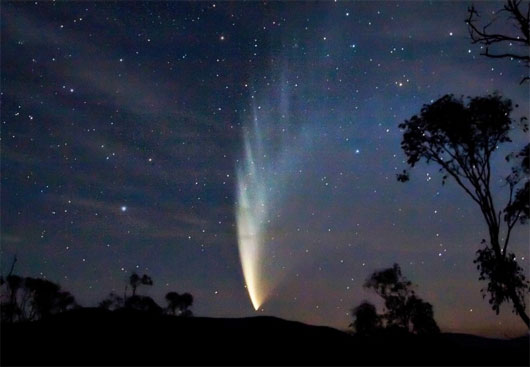Century comets
While waiting for the new comet to represent the 21st century, let's look back at the comet history over the past 500 years.
When ISON comet was discovered in 2012, astronomers quickly called it the comet of the century. Of course, the 21st century was only 12 years old at the time, and ISON turned out to end quickly under the heat of the sun. However, experts hope there are still a few candidates for this title out there, but it is expected that at least until 2029 will be revealed. Otherwise, wait until the 22nd century to appear, possibly in 2103.
Here are the comets represented in the last five centuries:
Comet in 1577
This comet moved into the space 26.87 million km away from the sun on October 27, 1577, but was not seen until 5 days later, when it was described as an extremely bright object in the sky. Heaven in Peru, comparable to the moon. On November 8, Japanese observers noted the appearance of a comet with its tail spread at more than 60 degrees. The famous astronomer of the time, Tycho Brahe, discovered it when he saw a reflection on the garden pond on November 13 and thought it was as bright as Venus. Comets continued to shine until December before disappearing from human view on January 26, 1978.

Comets always attract the attention of the Earth inhabitants - (Photo: prismnet.com)
Comet in 1680
It can be said that the excitement in astronomy when detecting the ISON comet is because its original orbit was very similar to comet in 1680, in the 17th century. Therefore, experts had hoped for ISON if not for the session. version 2.0 of the legendary comet, will also shine long in the sky of the earth. It is known that German astronomer Gottfried Kirch was the first to discover a comet with a telescope when he saw the comet on November 14, 1680. On December 2, it emitted an angle of 15 degrees, and on December 18, it was about 206,000 kilometers from the sun's surface. At least one report recorded many witnesses saw the comet during the day, and its tail continued to expand from 70 to 90 degrees, before falling to 55 degrees on January 20, 1681, 30. degree on January 23. The famous comet maintains its presence in the night sky until it disappears in early February 1681.
Comet in 1744
First revealed on November 29, 1743, the 18th-century comet quickly shone when approaching the sun. Many documents acknowledge that Mr. Philippe Loys de Cheseaux, the Lausanne (Switzerland) is the one who discovered it, although it took 2 weeks for the astronomer to see the silhouette of the comet. By mid-January 1744, the comet was exposed with a 7-degree angle. By February 1, it challenged Thien Lang (the brightest star in the sky) and on February 18, this comet could match Venus on brightness and radiate two tails. By March 6, comets carried 6 brilliant tails before disappearing afterwards.
Comet in 1882
This is probably the brightest comet ever witnessed by humans, and a giant member of the Kreutz comet family. First appearing in the southern hemisphere's sky on September 1, 1882, discovered by a group of Italian sailors, this comet became increasingly brighter as it approached the sun. By September 14, the man could see the comet during the day, and on December 17, it was only 424,866km from the surface of the sun. A day later, observers in Cordoba (Argentina) described comets as a shining star near the sun. However, the process of counterbalance does not cause the comet nucleus to break into at least 4 pieces, but still maintain enough shape for many days and weeks afterwards. Some historians still call it 'super comet'.
Comet in 1965
Ikeya-Seki is the brightest comet of the 20th century, discovered when it rushes towards the sun. Like the comets in 1843 and 1882, it belonged to the Kreutz family, and by October 21, it was only 1.19 million kilometers from the solar center. Ikeya-Seki displayed even during the day, and someone who wanted to see it just took the hand to cover the sun beside them. In Japan, where the comet was first discovered, Ikeya-Seki was described 10 times brighter than the full moon. And at the same time, the comet core was broken into 2 or 3 pieces.
- Comet 'century' approaches the Earth
- Century comet directs the sun
- Comets of the century were destroyed when flying near the Sun.
- Extremely special comets will appear in 2013
- In 2014, comets attacked Mars
- Comet - the mystery of the universe
- The list of 5 points can be answered on comets
- Li explained the destruction of comets
- Comets shed light on the early days of the solar system
- Twin comets fly closest to Earth within 250 years
- Comets can exist outside the solar system
- Comets bring life materials to Earth
 Van Allen's belt and evidence that the Apollo 11 mission to the Moon was myth
Van Allen's belt and evidence that the Apollo 11 mission to the Moon was myth The levels of civilization in the universe (Kardashev scale)
The levels of civilization in the universe (Kardashev scale) Today Mars, the sun and the Earth are aligned
Today Mars, the sun and the Earth are aligned The Amazon owner announced a secret plan to build a space base for thousands of people
The Amazon owner announced a secret plan to build a space base for thousands of people